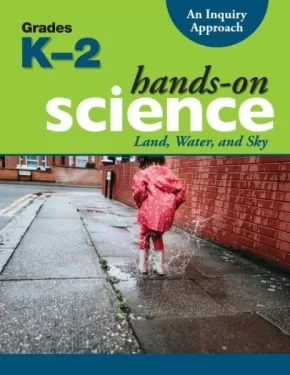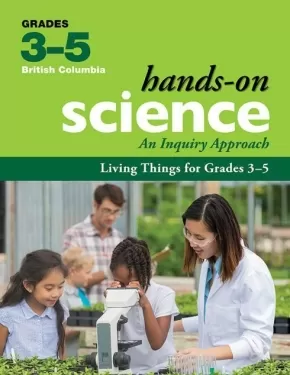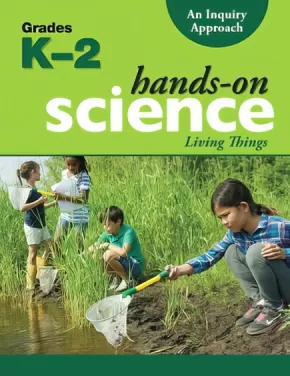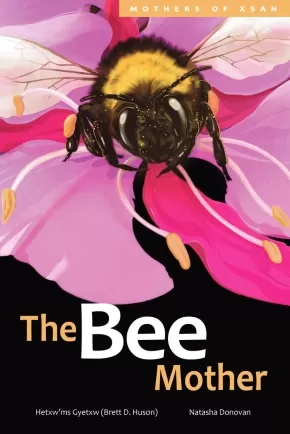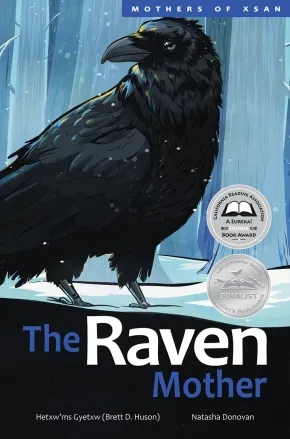
Hetxw’ms Gyetxw (Brett D. Huson)
Hetxw’ms Gyetxw (Brett D. Huson) is from the Gitxsan Nation, an Indigenous people from an unceded territory in the Northwest Interior of British Columbia, Canada. For the past decade, Brett has worked in the film and television industry, and has volunteered for such organizations as Ka Ni Kanichihk and Indigenous Music Manitoba. Growing up in a strong matrilineal society, Brett experienced and learned about the culture, land and political landscape he was born into. From this came a passion to create and share the knowledge and stories of his people, which reflect the importance of environmental balance and a cultural knowledge that spans thousands of years.
Books (3)
BC Hands-On Science: An Inquiry Approach - Land, Water, and Sky for Grades K-2
$92.00
Format: Coil Bound
Text Content Territories:
Indigenous Canadian;
ISBN / Barcode: 9781553797975
Synopsis:
Synopsis:
Land, Water, and Sky from Hands-On Science: An Inquiry Approach completely aligns with the redesigned Science Curriculum for British Columbia. Grounded in the Know-Do-Understand model, First Peoples’ knowledge and perspectives, and student-driven scientific inquiry, this custom-written resource:
- emphasizes Core Competencies, so students engage in deeper and lifelong learning
- develops Curricular Competencies as students explore science through hands-on activities
- fosters a deep understanding of the Big Ideas in science
Using proven Hands-On features, Land, Water, and Sky contains information and materials for both teachers and students including: Curricular Competencies correlation charts; background information on the science topics; complete, easy-to-follow lesson plans; reproducible student materials; and materials lists.
Innovative new elements have been developed specifically for the new curriculum:
- a multi-age approach
- a five-part instructional process—Engage, Explore, Expand, Embed, Enhance
- an emphasis on technology, sustainability, and personalized learning
- a fully developed assessment plan for summative, formative, and student self-assessment
- a focus on real-life Applied Design, Skills, and Technologies
- learning centres that focus on multiple intelligences and universal design for learning (UDL)
- place-based learning activities, Makerspace centres, and Loose Parts
In Land, Water, and Sky students investigate characteristics of the land, water, and sky. Core Competencies and Curricular Competencies will be addressed while students explore the following Big Ideas:
- Daily and seasonal changes affect all living things.
- Observable patterns and cycles occur in the local sky and landscape.
- Water is essential to all living things, and it cycles through the environment.
Educator Information
This book is from the Hands-On Science: An Inquiry Approach (for BC) series. The new Hands-On Science comprehensive resources completely align with the redesigned Science Curriculum for British Columbia.
Recommended for use with children ages 4-8.
Additional Information
150 pages | 8.5 " x 11"
BC Hands-On Science: An Inquiry Approach - Living Things for Grades 3-5
$92.00
Format: Coil Bound
Text Content Territories:
Indigenous Canadian;
ISBN / Barcode: 9781553798750
Synopsis:
Synopsis:
Living Things from Hands-On Science for British Columbia completely aligns with BC’s New Curriculum for Science. Grounded in the Know-Do-Understand model, First Peoples knowledge and perspectives, and student-driven scientific inquiry, this custom-written resource:
- emphasizes Core Competencies, so students engage in deeper and lifelong learning
- develops Curricular Competencies through hands-on activities
- fosters a deep understanding of the Big Ideas in science
Using proven Hands-On features, Living Things contains information and materials for both teachers and students including: Curricular Competencies correlation charts; background information on the science topics; complete, easy-to-follow lesson plans; reproducible student materials; and materials lists.
Innovative new elements have been developed specifically for the new curriculum:
- a multi-age approach
- an emphasis on technology, sustainability, and personalized learning
- a fully developed assessment plan for summative, formative, and student self-assessment
- a focus on real-life Applied Design, Skills, and Technologies
- learning centres that focus on multiple intelligences and universal design for learning (UDL)
- place-based learning activities and Makerspaces
Living Things for Grades 3-5 addresses Core Competencies and Learning Standards while students
explore the following Big Ideas:
- Living things are diverse, can be grouped, and interact in their ecosystems.
- All living things sense and respond to their environment.
- Multicellular organisms have organ systems that enable them to survive and interact within their environment.
Educator Information
This book is from the Hands-On Science: An Inquiry Approach (for BC) series. The new Hands-On Science comprehensive resources completely align with the redesigned Science Curriculum for British Columbia.
Recommended for use with students in grades 3 to 5.
Additional Information
150 pages | 8.50" x 11.00"
BC Hands-On Science: An Inquiry Approach - Living Things for Grades K-2
$92.00
Format: Coil Bound
Text Content Territories:
Indigenous Canadian;
ISBN / Barcode: 9781553797555
Synopsis:
Synopsis:
Living Things from Hands-On Science: An Inquiry Approach completely aligns with the redesigned Science Curriculum for British Columbia. Grounded in the Know-Do-Understand model, First Peoples’ knowledge and perspectives, and student-driven scientific inquiry, this custom-written resource:
- emphasizes Core Competencies, so students engage in deeper and lifelong learning
- develops Curricular Competencies as students explore science through hands-on activities
- fosters a deep understanding of the Big Ideas in science
Using proven Hands-On features, Living Things contains information and materials for both teachers and students including: Curricular Competencies correlation charts; background information on the science topics; complete, easy-to-follow lesson plans; reproducible student materials; and materials lists.
Innovative new elements have been developed specifically for the new curriculum:
- a multi-age approach
- a five-part instructional process—Engage, Explore, Expand, Embed, Enhance
- an emphasis on technology, sustainability, and personalized learning
- a fully developed assessment plan for summative, formative, and student self-assessment
- a focus on real-life Applied Design, Skills, and Technologies
- learning centres that focus on multiple intelligences and universal design for learning (UDL)
- place-based learning activities, Makerspace centres, and Loose Parts
In Living Things students investigate plants and animals. Core Competencies and Curricular Competencies will be addressed while students explore the following Big Ideas:
- Plants and animals have observable features.
- Living things have features and behaviours that help them survive in their environment.
- Living things have life cycles adapted to their environment.
Educator Information
This book is from the Hands-On Science: An Inquiry Approach (for BC) series. The new Hands-On Science comprehensive resources completely align with the redesigned Science Curriculum for British Columbia.
Recommended for use with children ages 4-8.
Additional Information
150 pages | 8.5 " x 11"
Kids Books (8)
The Bee Mother
$24.95
Artists:
Format: Hardcover
Text Content Territories:
Indigenous Canadian; First Nations; Gitxsan (Gitksan);
ISBN / Barcode: 9781774920800
Synopsis:
Synopsis:
Discover the important role of bumblebees, honeybees, and wasps as pollinators in this colourful picture book for young scientists.
Learn about the life cycles of different kinds of bees in this enlightening picture book.
As flowers and trees begin to bud and bloom, Nox Ap, the bee mother, emerges from her winter sleep. To the Gitxsan, she is nature’s gardener. Without her hard work as a pollinator, we could not enjoy the fruits of strawberries and huckleberries. Follow her life from the first thaw of spring to the end of autumn.
In the seventh book of Hetxw'ms Gyetxw (Brett D. Huson)’s Mothers of Xsan series, readers will discover the important role of the bumblebee, the honeybee, and the yellow jacket wasp in the Xsan ecosystem.
Reviews
“Described with delicious adjectives (“pillowy moss floor”) that enrich the story...lushly colored and detailed; the fur on the bumblebee looks ready to be brushed. This great blend of nonfiction with narrative and amazing illustrations will engage readers in the life of bees and their significance to the Gitxsan Nation. A solid general purchase.” — School Library Journal
"A valuable addition to any school library, this book is ideal for grade 2 to 6 lessons about life cycles, biodiversity, biomes, and First Peoples Knowledge of sustainability and stewardship." - Melanie M., Elementary School Teacher, Indigenous Books for Schools
Educator & Series Information
Recommended for ages 9 to 12.
This book is part of the Mother of Xsan series, which uses striking illustration and lyrical language to bring the poetry of the Xsan ecosystem to life. It is the seventh book in the series.
Reading Level: Fountas & Pinnell T
Lexile® Framework for Reading: 1140L
This book is included in the Indigenous Books for Schools database from the Association of Book Publishers of BC. It is recommended for Grades 2 to 6 for English Language Arts and Science.
Themes: Animals, Land, Language, Sustainability, Life Cycles, Biodiversity, Interdependence, Seasons
Additional Information
32 pages | 6.50" x 10.00" | Hardcover
The Cedar Mother
$24.95
Artists:
Format: Hardcover
Text Content Territories:
Indigenous Canadian; First Nations; Gitxsan (Gitksan);
ISBN / Barcode: 9781774921586
Synopsis:
Synopsis:
From small sapling to towering giant, follow the long life of a cedar tree in this illustrated book for young scientists.
Step outside to explore the hidden mysteries of the cedar tree life cycle in this beautifully illustrated, engaging non-fiction book for young scientists ages 9 to 12.
Meet Nox Sim Gan, the cedar mother, whose life cycle spans centuries and whose roots anchor the landscape. The cedar mother plays a vital role in the ecosystem: offering shelter for birds in her strong limbs, providing refuge for small creatures beneath her bark, and healing the Gitxsan with a medicinal tea made from her soft, green leaves. She also creates the very oxygen that all land-dwelling creatures need to breathe.
Delve into the remarkable story of the western red cedar as you learn how she nourishes herself through an unexpected connection to salmon, the secret web of life that thrives beneath the ground, and how, at the end of her life, she leaves a final gift for the Gitxsan. This book invites young readers to discover the life of a tree that is much more than meets the eye, offering lessons in interconnectedness, and in wisdom passed down through generations.
Educator & Series Information
Recommended for ages 9 to 12.
Lexile measure: 1050L
This book is part of the Mother of Xsan series, which uses striking illustration and lyrical language to bring the poetry of the Xsan ecosystem to life. It is the eighth book in the series.
Additional Information
32 pages | 6.50" x 10.00" | Hardcover
The Eagle Mother
$23.00
Artists:
Format: Hardcover
Text Content Territories:
Indigenous Canadian; First Nations; Gitxsan (Gitksan);
ISBN / Barcode: 9781553798590
Synopsis:
Synopsis:
Return to the valleys of the River of Mists with award-winning author Hetxw'ms Gyetxw (Brett D. Huson). Nox xsgyaak, the eagle mother, cares for her brood in the embrace of a black cottonwood with the help of her mate. Will both eaglets survive the summer in an environment that is both delicate and unforgiving?
Learn about the life cycle of these stunning birds of prey, the traditions of the Gitxsan, and how bald eagles can enrich their entire ecosystem. Evocative illustration brings the Xsan's flora and fauna to life for middle years readers in book three of the Mothers of Xsan series.
Reviews
“The Eagle Mother by Hetxw’ms Gyetxw (Brett D. Huson) and illustrator Natasha Donovan, the third in the Mothers of Xsan series, which offers a perspective on the life cycle of animals important to the land and to people.”— Publishers Weekly
"For further learning about the Gitxsan, the author has included a glossary titled "The Gitxsan Moons" and a summary of Gitxsan Nation clans" - Canadian Indigenous Books for Schools 2020/2021
Educator & Series Information
Recommended ages: 9 to 12 (Grades 3 to 7).
This is the third book in the Mothers of Xsan series, which uses striking illustration and lyrical language to bring the poetry of the Xsan ecosystem to life. The traditional Gitxsan formline art and language weave together throughout the stories in this series to paint a vivid picture of the Gitxsan people.
The Mothers of Xsan series is a collection of stories that connect the world to the matrilineal society of the Gitxsan people, located in Northwestern British Columbia. It presents scientific knowledge in language and a format that is accessible. Each book in the series showcases the depth and importance of the knowledge that has been gathered and shared through this unique style of storytelling. The stories of life cycle, connection the land and language are told from the perspective of the Mothers of Xsan system's animals.
Recommended in the Canadian Indigenous Books for Schools 2020/2021 resource list as being useful for grades 1-4 in the areas of Language Arts, Science, and Social Studies.
Additional Information
32 pages | 6.50" x 10.00"
The Frog Mother
$23.00
Artists:
Format: Hardcover
Text Content Territories:
Indigenous Canadian; First Nations; Gitxsan (Gitksan);
ISBN / Barcode: 9781553799016
Synopsis:
Synopsis:
To the Gitxsan of Northwestern British Columbia, Nox Ga’naaw is a storyteller, speaking truths of the universe. After Nox Ga’naaw, the frog mother, releases her eggs among the aquatic plants of a pond, the tiny tadpoles are left to fend for themselves. As they hatch, grow legs, and transform into their adult selves, they must avoid the mouths of hungry predators. Will the young frogs survive to spawn their own eggs, continuing a cycle 200 million years in the making?
Book four of the Mothers of Xsan series follows the life cycle of the Columbia Spotted Frog. Learn about why this species is of special significance to the Gitxsan and how Nox Ga'naaw and her offspring are essential to the balance that is life.
Reviews
"In his engaging book, Hetxw'ms Gyetxw enhances plain biological facts by putting them in their cultural context; for example, the Frog Mother reflects the Gitxsan Nation’s matrilineal system. Donovan provides wonderfully sinuous illustrations that deftly capture frog movement and utilize color." — Kirkus Reviews
Educator & Series Information
Recommended ages: 9 to 12
This is the fourth book in the Mothers of Xsan series, which uses striking illustration and lyrical language to bring the poetry of the Xsan ecosystem to life. The traditional Gitxsan formline art and language weave together throughout the stories in this series to paint a vivid picture of the Gitxsan people.
Mothers of Xsan is a collection of stories that connects the world to the matrilineal society of the Gitxsan people, located in the Pacific Northwest Interior of British Columbia. Each book in the Mothers of Xsan series showcases the depth and importance of the knowledge that has been gathered and shared through this unique style of storytelling. The stories of life cycles, connection to the land, and language are told from the perspective of the animals from the Gitxsan’s traditional territory.
The series presents scientific knowledge in language and a format that is accessible.
Additional Information
32 pages | 6.50" x 10.00"
The Grizzly Mother
$23.00
Artists:
Format: Hardcover
Text Content Territories:
Indigenous Canadian; First Nations; Gitxsan (Gitksan);
ISBN / Barcode: 9781553797760
Synopsis:
Synopsis:
An engaging look at how the animals, people, and seasons within an ecosystem are intertwined.
To the Gitxsan people of Northwestern British Columbia, the grizzly is an integral part of the natural landscape. Together, they share the land and forests that the Skeena River runs through, as well as the sockeye salmon within it. Follow mother bear as she teaches her cubs what they need in order to survive on their own.
The Mothers of Xsan series uses striking illustration and lyrical language to bring the poetry of the Xsan ecosystem to life.
Awards
- Animal Behavior Society's Outstanding Children's Book Award
- 2020 Manuela Dias Design and Illustration Awards, Children's Illustration winner
Educator & Series Information
Recommended for ages 9 - 12.
This is the second book in the Mother of Xsan series, which uses striking illustration and lyrical language to bring the poetry of the Xsan ecosystem to life.
Recommended in the "Canadian Indigenous Books for Schools 2019-2020" resource list as being useful for students in grades 2-5 in these subject areas: English Language Arts, Science, Social Studies.
Additional Information
32 pages | 6.50" x 10.00"
The Raven Mother
$24.95
Artists:
Format: Hardcover
Text Content Territories:
Indigenous Canadian; First Nations; Gitxsan (Gitksan);
ISBN / Barcode: 9781774920039
Synopsis:
Synopsis:
Bring science to life with this book about ravens, their role in the food web, and how they benefit their ecosystem.
Hoarders. Scavengers. Clever foragers. Bringers of new life.
Ravens have many roles, both for the land and in Gitxsan story and song. The sixth book in Hetxw'ms Gyetxw (Brett D. Huson)’s Mothers of Xsan series transports young readers to Northwestern British Columbia, where they will learn about the traditions of the Gitxsan, the lives of ravens, and why these acrobatic flyers are so important to their ecosystem.
Follow along as Nox Gaak, the raven mother, teaches her chicks what they need to survive with the help of her flock.
Educator & Series Information
Recommended for ages 9 to 11.
This book is part of the Mother of Xsan series, which uses striking illustration and lyrical language to bring the poetry of the Xsan ecosystem to life.
Additional Information
32 pages | 6.50" x 10.00" | Hardcover
The Sockeye Mother
$23.00
Artists:
Format: Hardcover
Text Content Territories:
Indigenous Canadian; First Nations; Gitxsan (Gitksan);
ISBN / Barcode: 9781553797395
Synopsis:
Synopsis:
To the Gitxsan people of Northwestern British Columbia, the sockeye salmon is more than just a source of food. Over its life cycle, it nourishes the very land and forests that the Skeena River runs through and where the Gitxsan make their home. The Sockeye Mother explores how the animals, water, soil, and seasons are all intertwined.
1 SMALL FRY
There’s a strong undertow today. The turbulent waters caress the backs of the little semelparous life forms emerging from their gravel nests. A small free-swimming fry bears witness to the currents of spring, after spending weeks developing and using up its nutritious yolk sack. It’s one of few remaining fry leaving its long winter’s home to seek out nursing waters.
This is the time of Wihlaxs (the black bear’s walking moon), which is early spring to the Gitxsan peoples of the Pacific Northwest Interior. Change is in the air, the days grow longer, and renewal is the life force that guides the world around the little fry’s waterways. Flora cells are starting to stir, preparing to bud and bring green to the landscape. Stores of food for the people along Xsan (river of mists) is running low, but preparations for the new seasons of fishing and gathering have begun. New snow falls to take away the old snow, which the Gitxsan call dalugwa.
Miso’o, or sockeye, are one of many species of salmon that call Xsan home. Although all species are valued, the Gitxsan prefer the flavour and number of Sockeye that return to their spawning grounds every year. The cultures along Xsan, otherwise known as the Skeena River, flourished and shaped their existence around the life cycles of this keystone species. Little does this small sockeye fry know that its life cycle not only nourishes the people and other beings along the watersheds, it is the whole reason the forests and landscapes exist.
2 TIME TO GROW
After a couple of years of “schooling” in the deeper parts of the nursing lake, this sockeye has become a smolt. Its little silvery body begins taking the shape of its blue-backed future self. The smolt is outgrowing the lake, and this signals Lasa ya’a (the spring salmon’s returning moon), so the little sockeye begins its treacherous journey down the Skeena.
As the spring salmons return, the sockeye smolts depart to relieve their urge for saliferous waters. April carries summer innuendos, as warm winds flow through nearly blooming flowers. The scent of pines and cedar waft across moist pillowy moss. The nets and rods of the Gitxsan people scour Xsan in hopes of taking part in the return of ya’a, the spring salmon. Ceremony is held and feasts occur to welcome the runs of salmon who come to replenish the land. It’s not only a time to give thanks, but also a time to send prayer that the salmon will always return, that they will provide nourishment for all that is living within its realm.
The young sockeye has so far avoided predation, dodged the unnaturally changing landscape denuding from the clear-cutting of man, and escaped the hungry hands of ’watxs, the otter. The smolt and her school have made their journey to the Pacific, and north to the ocean waters, where they will continue to feed and grow.
3 A REPLENISHING DEATH
For two years the sockeye mother has been feeding in the ocean waters, while avoiding sharks and killer whales. Through instinct, smell and much that is still not understood, the sockeye mother swims against the powerful currents of Xsan to return to the exact place in the rivers where she was spawned.
It’s now Lasa lik’i’nxsw (the grizzly bear’s moon). August is the time when all the Gitxsan people and grizzly bears pluck hundreds of thousands of sockeye from the Skeena. Many predators such as the grizzly discard most of the carcass. They carry their catch sometimes hundreds of metres into the forest, only to eat the fatty bellies and eggs. The decaying bodies of the salmon leaves nitrogen that nourishes the soil.
Battered and beaten by the journey, she is literally decaying due to lack of food and constant hard work. She finds a male partner who’s dug a nest to her liking. She lays her eggs. She can now die a replenishing death. The dying salmon bodies become fertilizer for all the flora that shape the great lands. Without the sockeye mother, the Gitxsan as they are, would simply not exist.
Awards
- The Science Writers and Communicators of Canada Award, Youth Category.
- McNally Robinson Book for Young People Award
Educator & Series Information
Recommended for Grades 4-7 for theses subject areas: Science, Social Studies.
This book is part of the Mother of Xsan series, which uses striking illustration and lyrical language to bring the poetry of the Xsan ecosystem to life.
Additional Information
| 32 pages | 6.50" x 10.00" |
The Wolf Mother
$23.00
Artists:
Format: Paperback
Text Content Territories:
Indigenous Canadian; First Nations; Gitxsan (Gitksan);
ISBN / Barcode: 9781553799788
Synopsis:
Synopsis:
Follow along as award-winning author Hetxw’ms Gyetxw (Brett D. Huson) introduces young readers to a pack of gray wolves. New pups have just begun to open their eyes, one of which is a striking black female. Every day, her ears grow larger, her eyesight gets sharper, and her legs stretch farther. As she learns to hunt, play, and run with her pack, instinct pulls her to explore beyond her home territory. Will the young wolf’s bold spirit help her find a new pack of her very own?
Learn about the life cycle of these magnificent canines, the traditions of the Gitxsan, and how gray wolves contribute to the health of their entire ecosystem.
Educator & Series Information
Recommended ages: 9 to 11
This is the fifth book in the Mothers of Xsan series, which uses striking illustration and lyrical language to bring the poetry of the Xsan ecosystem to life. The traditional Gitxsan formline art and language weave together throughout the stories in this series to paint a vivid picture of the Gitxsan people.
Mothers of Xsan is a collection of stories that connects the world to the matrilineal society of the Gitxsan people, located in the Pacific Northwest Interior of British Columbia. Each book in the Mothers of Xsan series showcases the depth and importance of the knowledge that has been gathered and shared through this unique style of storytelling. The stories of life cycles, connection to the land, and language are told from the perspective of the animals from the Gitxsan’s traditional territory.
The series presents scientific knowledge in language and a format that is accessible.
Additional Information
32 pages | 6.50" x 10.00" | Paperback

